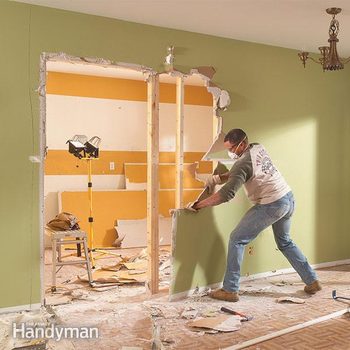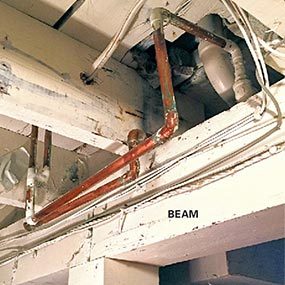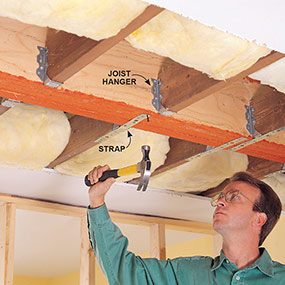Can You Take a Wall Out That Is Load Bearing
Can I Remove This Wall? Removing a Load-Bearing Beam
Almost any wall tin be removed-it'south a matter of how much you lot're willing to spend

People are ever request remodeling contractors, 'Tin can I remove this wall?' And the answer is, 'Yes, any wall can be removed. But there are a lot of factors that touch the difficulty and cost of the job.' In this article, we'll explain these factors, including how to tell if the wall is load bearing, what hidden costs you may see, and what professional services you'll need to rent to get the task done.
You might besides like: TBD
What'due south within the wall? How to tell if a wall is load bearing
Y'all might think the first thing you should figure out is whether the wall is load bearing (more on that later). But in fact, what's inside the wall can nowadays a much bigger obstacle. Heating, plumbing and electrical lines will have to be rerouted. And sometimes, moving those lines is a huge task-so difficult that removing the wall just isn't practical. Effigy A shows the most mutual things plant within a wall.
A chief drain running through the wall from a second-floor bathroom could exist very difficult and expensive to reroute. Heating and air conditioning ducts often run through interior walls, and these tin can exist hard to relocate. So the first footstep is to effigy out what'southward hidden backside the drywall.
Figure A: What'southward Within a Wall
- Air ducts almost always sew together and down through the wall. Supply ducts are usually canvass metal, and coldair returns similar the i shown here use the stud space. If you lot discover either one, you'll have to observe a way to relocate information technology. If the duct is supplying a room above, this can be a difficult job.
- Water pipes can run vertically or horizontally-that gives you a lot of flexibility in relocating them. Just remember that in cold climates you can't run them in exterior walls.
- Waste matter and vent lines aren't always easy to motion because of plumbing restrictions on turns and horizontal runs. You lot may need a building inspector'southward advice.
- Gas pipes are relatively easy to relocate, simply yous may need to hire a plumber to practise it.
- Wiring is one of the easiest things to motility, but all connections must be made within a code-approved electric box and the box must exist left accessible. Y'all can't bury a junction box in the flooring or ceiling.
Detective Tips
You can't exist absolutely certain what'south within a wall until you tear off the drywall. But you can oftentimes get a very skilful preview by looking for a few clues:
- Cover plates, grilles or fixtures-look on both sides of the wall.
- Pipes or wires exiting the wall in the attic above or the basement below the wall.
Is information technology a bearing wall? How do y'all know if a wall is load bearing
Only some of your walls are needed to hold up your firm. These are called begetting walls. The rest of the walls, the partition walls, are simply at that place to divide rooms. You tin remove either blazon of wall, but if the wall is load begetting, you accept to take special precautions to back up the construction during removal, and to add a beam or other class of back up in its identify.
Then how practise you know whether a wall is load bearing? Some bearing walls are like shooting fish in a barrel to spot (see the central wall in Figure B). If your wall conforms to the situation shown, yous can be sure it's load bearing.
Ceiling or floor joists that are spliced over the wall, or end at the wall, mean the wall is begetting. Await for these from the attic. Walls that are stacked may be load begetting. Find these by measuring or past studying a floor program of your firm. In some cases, you may not exist able to tell for sure whether a wall is bearing. If you're non certain, hire a contractor or structural engineer to assistance yous effigy it out.
Figure B: Types of Walls
- The outside walls are supporting the roof, and so they're begetting walls.
- A beam directly under a wall commonly means that it'south a bearing wall, whether the beam is in a crawl space, basement or on the primary floor.
- Ceiling joists that run into over the wall indicate that it's a bearing wall. It is conveying the weight of the ceiling.
Options for replacing a bearing wall
If you desire to remove a begetting wall, the chief matter to keep in mind is that you have to replace the wall with some other means of back up, and transfer the weight downwards to the foundation. There are a few different ways to do this. Figure C shows a typical state of affairs where a beam is installed under the ceiling. But you tin also hibernate the beam by recessing information technology (Figure D).
Adding a axle is only part of the solution. You also have to support the ends with posts. And the posts take to bear the load to the foundation. Figure C shows one instance of how this works. If you add new posts in the basement, they should residual on footings (Figure E).
If yous plan to remove a bearing wall, nosotros recommend hiring a structural engineer. An engineer volition inspect the house, calculate the size of the axle and posts yous'll need, and determine whether yous'll demand to add support under the posts. In most cases, the urban center volition require beam calculations in order to approve a let, so the money spent on an engineer won't exist wasted. Phone call around to find a structural engineer who'south familiar with residential construction and is willing to take on a small job at a reasonable cost. Expect to spend $300 to $1,000 for this service.
If you're interested in the footstep-by-step process of removing a bearing wall and adding a beam, check out How to Install a Load-Bearing Axle.
Effigy D: Adding a beam flush to the ceiling
Figure East: Posts require footings
What else should I know before I remove a wall?
Taking out a wall is 1 of those projects that can mushroom into a lot more piece of work than you originally intended. For example, it's easy to overlook the fact that y'all'll have to patch or replace the flooring. If you have hardwood floors, and the boards run parallel to the wall you're removing, you lot can hands patch in floorboards. Only you'll nevertheless have to refinish the floors to blend in the patch. If the flooring boards run perpendicular to the wall, the job gets a lot more difficult.
If yous have carpet, tile, vinyl or laminate flooring, you lot'll probably take to supplant it or put up with an obvious patch. The only other option is to install a strip of wood or some other threshold-like treatment to cover the gap where the wall was. And remember, you'll as well have to patch the walls and ceiling aslope the new beam and posts, and touch upwardly or repaint the newly joined rooms. Adding these costs to the upkeep now will avoid surprises later.
Source: https://www.familyhandyman.com/project/can-i-remove-this-wall-removing-a-load-bearing-beam/




0 Response to "Can You Take a Wall Out That Is Load Bearing"
Post a Comment